GENERALSOLUTIONS 101
Greetings! in this page you will get access with education resources practice questions with answers and study materials modified to empower and enhance your knowledge, I will be sharing all materials, study guides, tests, Q&As, test banks, Hesi questions, etc. on my page for . Best of luck to you all! Happy studying!
- 263
- 0
- 1
Community
- Followers
- Following
264 items
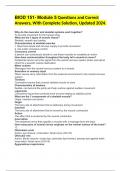
BIOD 151- Module 5 Questions and Correct Answers, With Complete Solution, Updated 2024.
Why do the muscular and skeletal systems work together? To provide movement for the human body What are the 3 types of muscle tissue? Skeletal, smooth and cardiac Characteristics of skeletal muscles 1. Must have blood and nervous supply to provide movement 2. Are under conscious control Conscious control a person can consciously decide to use these muscles to complete an action How does communication throughout the body tell a muscle to move? Peripheral nerves carry the signal from the...
- Exam (elaborations)
- • 13 pages •
Why do the muscular and skeletal systems work together? To provide movement for the human body What are the 3 types of muscle tissue? Skeletal, smooth and cardiac Characteristics of skeletal muscles 1. Must have blood and nervous supply to provide movement 2. Are under conscious control Conscious control a person can consciously decide to use these muscles to complete an action How does communication throughout the body tell a muscle to move? Peripheral nerves carry the signal from the...
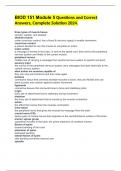
BIOD 151 Module 5 Questions and Correct Answers, Complete Solution 2024.
three types of muscle tissue smooth, cardiac, and skeletal skeletal muscle under conscious control; has a blood & nervous supply to enable movement conscious control a person decided to use this muscle to complete an action motor action a message is formed in the brain, is sent to the spinal cord, then sent to the peripheral nervous system and finally to the correct muscle peripheral nerves middle man of carrying a message from central nervous system to specific end point sensory input...
- Exam (elaborations)
- • 5 pages •
three types of muscle tissue smooth, cardiac, and skeletal skeletal muscle under conscious control; has a blood & nervous supply to enable movement conscious control a person decided to use this muscle to complete an action motor action a message is formed in the brain, is sent to the spinal cord, then sent to the peripheral nervous system and finally to the correct muscle peripheral nerves middle man of carrying a message from central nervous system to specific end point sensory input...
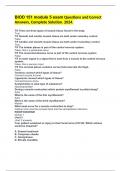
BIOD 151 module 5 exam Questions and Correct Answers, Complete Solution. 2024.
T/F There are three types of muscle tissue found in the body. True T/F Smooth and cardiac muscle tissue are both under voluntary control. False T/F Cardiac and smooth muscle tissue are both under involuntary control True T/F The lumbar plexus is part of the central nervous system. False- this is a peripheral nerve T/F The musculocutaneous nerve is part of the central nervous system False T/F A motor signal is a signal that is sent from a muscle to the central nervous system. False- th...
- Exam (elaborations)
- • 5 pages •
T/F There are three types of muscle tissue found in the body. True T/F Smooth and cardiac muscle tissue are both under voluntary control. False T/F Cardiac and smooth muscle tissue are both under involuntary control True T/F The lumbar plexus is part of the central nervous system. False- this is a peripheral nerve T/F The musculocutaneous nerve is part of the central nervous system False T/F A motor signal is a signal that is sent from a muscle to the central nervous system. False- th...
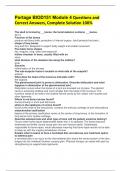
Portage BIOD151 Module 4 Questions and Correct Answers, Complete Solution 100%
The skull is formed by___bones; the facial skeleton contains ___bones. 22;14 Function of flat bones produce red blood cells; protection of internal organs. (skull protects the brain). shape of long bones long and thin; designed to support body weight and enable movement Five basic bone shapes flat, irregular, long, short and sesamoid hollow chamber in bone, usually filled with air sinus what division of the skeleton lies along the midline? axial Sinusitis inflammation of the sinuses...
- Exam (elaborations)
- • 2 pages •
The skull is formed by___bones; the facial skeleton contains ___bones. 22;14 Function of flat bones produce red blood cells; protection of internal organs. (skull protects the brain). shape of long bones long and thin; designed to support body weight and enable movement Five basic bone shapes flat, irregular, long, short and sesamoid hollow chamber in bone, usually filled with air sinus what division of the skeleton lies along the midline? axial Sinusitis inflammation of the sinuses...
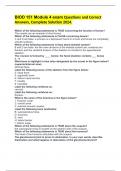
BIOD 151 Module 4 exam Questions and Correct Answers, Complete Solution 2024
Which of the following statements is TRUE concerning the function of bones? The carpals are an example of short bones. Which of the following statements is FALSE concerning bones? C and D are false: a process is a depression found in a bone and bones are completely smooth surfaces. Which of the following statements is false about skeletal system? B and D are false: the two main divisions of the skeletal system are: vertebral and thoracic and the vertebral division of the skeleton is include...
- Exam (elaborations)
- • 3 pages •
Which of the following statements is TRUE concerning the function of bones? The carpals are an example of short bones. Which of the following statements is FALSE concerning bones? C and D are false: a process is a depression found in a bone and bones are completely smooth surfaces. Which of the following statements is false about skeletal system? B and D are false: the two main divisions of the skeletal system are: vertebral and thoracic and the vertebral division of the skeleton is include...
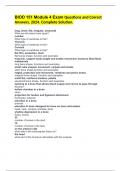
BIOD 151 Module 4 Exam Questions and Correct Answers, 2024. Complete Solution
long, short, flat, irregular, sesamoid What are the basic bone types? Lumbar What type of vertebrae is this? Thoracic What type of vertebrae is this? Cervical What type of vertebrae is this? flat thin, protection, skull flat bones shape, function and examples long thin, support body weight and enable movement, humerus tibia fibula metatarsals long bone shape, functions and examples small cube shaped, movement, carpals and tarsals short bone shape function and examples ridged, prote...
- Exam (elaborations)
- • 3 pages •
long, short, flat, irregular, sesamoid What are the basic bone types? Lumbar What type of vertebrae is this? Thoracic What type of vertebrae is this? Cervical What type of vertebrae is this? flat thin, protection, skull flat bones shape, function and examples long thin, support body weight and enable movement, humerus tibia fibula metatarsals long bone shape, functions and examples small cube shaped, movement, carpals and tarsals short bone shape function and examples ridged, prote...
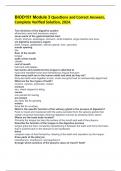
BIOD151 Module 3 Questions and Correct Answers, Complete Verified Solution, 2024.
Two divisions of the digestive system alimentary canal and accessory organs seven parts of the gastrointestinal tract mouth, pharynx, esophagus, stomach, small intestine, large intestine and anus six digestive accessory organs teeth, tongue, gallbladder, salivary glands, liver, pancreas mouth opening lips floor of the mouth tongue walls of the mouth cheeks roof of mouth hard and soft palates two bones and membrane the tongue is attached to hyoid and mandible bone and membranous li...
- Exam (elaborations)
- • 5 pages •
Two divisions of the digestive system alimentary canal and accessory organs seven parts of the gastrointestinal tract mouth, pharynx, esophagus, stomach, small intestine, large intestine and anus six digestive accessory organs teeth, tongue, gallbladder, salivary glands, liver, pancreas mouth opening lips floor of the mouth tongue walls of the mouth cheeks roof of mouth hard and soft palates two bones and membrane the tongue is attached to hyoid and mandible bone and membranous li...
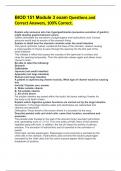
BIOD 151 Module 3 exam Questions and Correct Answers, 100% Correct.
Explain why someone who has hypergastrinemia (excessive secretion of gastrin) might develop gastric/stomach ulcers. Gastrin stimulates the secretions of pepsinogens and hydrochloric acid. Excess amounts would lead to erosion of the stomach lining. Explain in detail how the stomach contents enter the small intestine The pyloric sphincter (valve), located at the base of the stomach, relaxes causing a small quantity of chyme to pass through the opening into the first part of the small intest...
- Exam (elaborations)
- • 4 pages •
Explain why someone who has hypergastrinemia (excessive secretion of gastrin) might develop gastric/stomach ulcers. Gastrin stimulates the secretions of pepsinogens and hydrochloric acid. Excess amounts would lead to erosion of the stomach lining. Explain in detail how the stomach contents enter the small intestine The pyloric sphincter (valve), located at the base of the stomach, relaxes causing a small quantity of chyme to pass through the opening into the first part of the small intest...
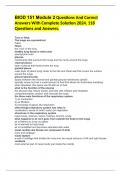
BIOD 151 Module 2 Questions And Correct Answers With Complete Solution 2024. 118 Questions and Answers.
True or false. The lungs are symmetrical. False Hilum the "root" of the lung healthy lung tissue is what color peachy/pink color pleurae membranes that surround the lungs and the cavity around the lungs visceral pleura layer of pleura that faces/covers the lung parietal pleura outer layer of pleura lying closer to the ribs and chest wall that covers the surface around the lungs pleural space/cavity Space between the visceral and parietal pleural membranes (small) typically empty...
- Exam (elaborations)
- • 8 pages •
True or false. The lungs are symmetrical. False Hilum the "root" of the lung healthy lung tissue is what color peachy/pink color pleurae membranes that surround the lungs and the cavity around the lungs visceral pleura layer of pleura that faces/covers the lung parietal pleura outer layer of pleura lying closer to the ribs and chest wall that covers the surface around the lungs pleural space/cavity Space between the visceral and parietal pleural membranes (small) typically empty...
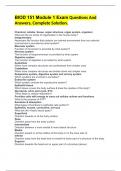
BIOD 151 Module 1 Exam Questions And Answers, Complete Solution.
Chemical, cellular, tissue, organ structure, organ system, organism What are the six levels of organization in the human body? Integumentary Necessary life function that protects our internal environment from our external environment is provided by what system? Muscular system Function of movement is provided by what system? Nervous system The function of responsiveness is provided by what system Digestive system The function of digestion is provided by what system Anabolism When more...
- Exam (elaborations)
- • 5 pages •
Chemical, cellular, tissue, organ structure, organ system, organism What are the six levels of organization in the human body? Integumentary Necessary life function that protects our internal environment from our external environment is provided by what system? Muscular system Function of movement is provided by what system? Nervous system The function of responsiveness is provided by what system Digestive system The function of digestion is provided by what system Anabolism When more...
